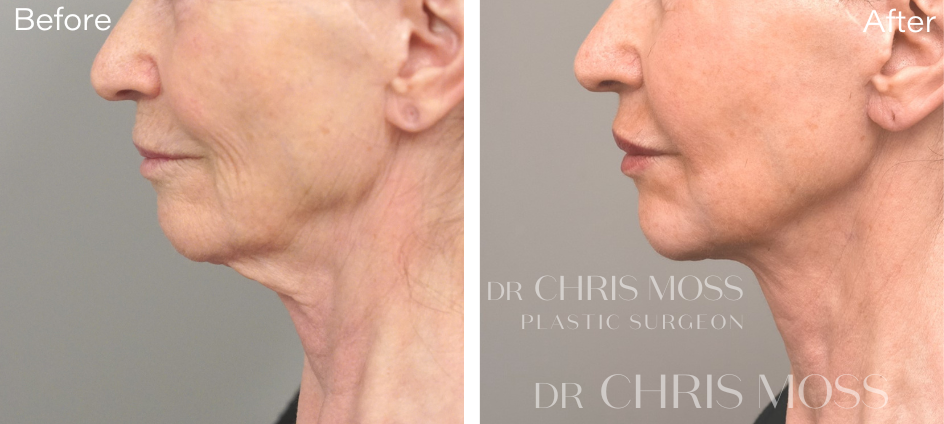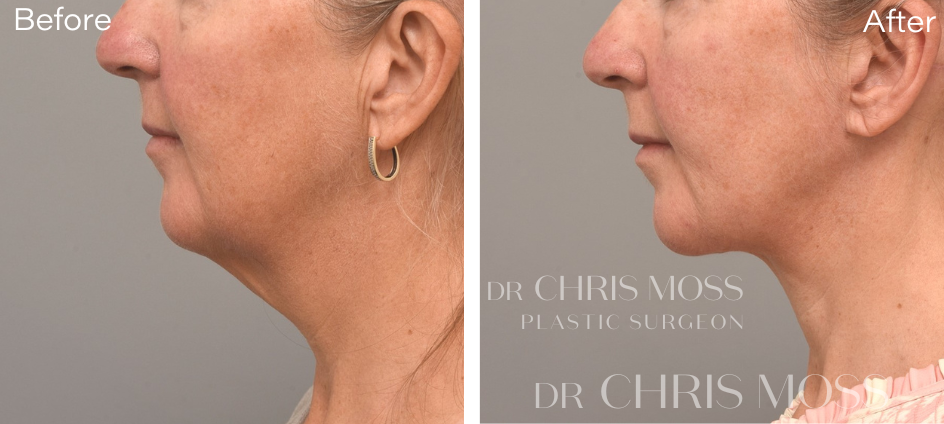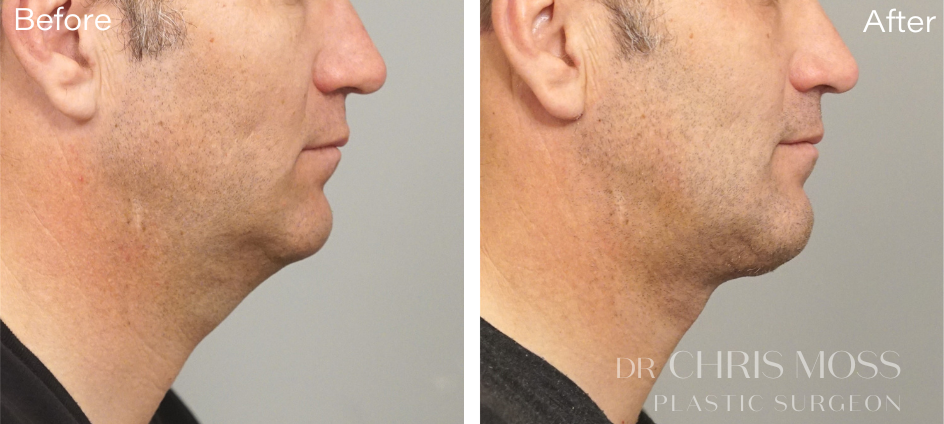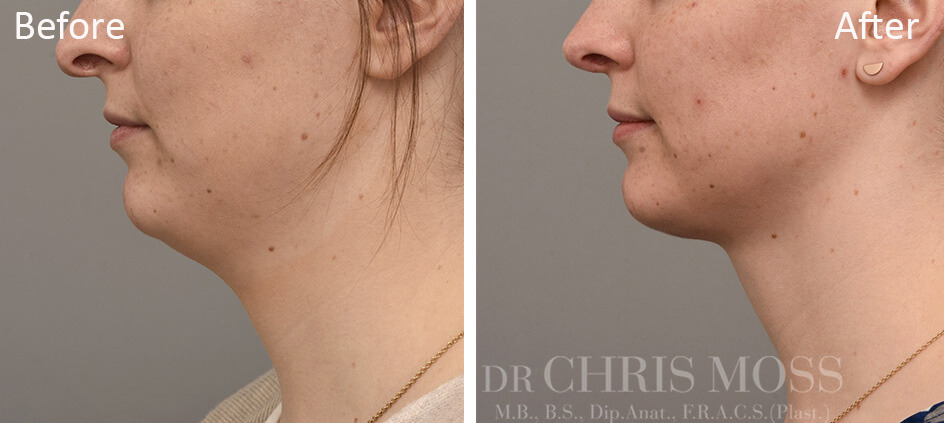Neck Lift Surgery by Dr Chris Moss
Neck lift surgery removes excess skin, reduces excess fatty tissues and improves the contour and firmness of the neck.
Most commonly Dr Moss performs neck lift procedures at the same time as a Facelift for extra neck firming or contouring. There are however, many patients who have little or no facial ageing or, for personal reasons, do not want surgery to their face. Those patients, whose concerns are limited to their neck only, are often surprised yet happy to hear that Dr Moss regularly performs neck lift or neck contouring surgery alone.
In the past patients with significant excess skin in the neck traditionally needed to undergo a facelift procedure with the neck lift – whether or not they were concerned about their facial ageing. Dr Moss performs modern Neck Lift techniques that can now offer substantial neck benefits as standalone procedures without any Facelift being performed.
Disclaimer: Results vary from person to person. These images are indicative only and reflect the results for this patient. All surgery involves risks & a recovery period – see below.

BEFORE:
Areas of Concern for Treatment
- Contour & skin tone of neck
- Volume loss around the mouth.
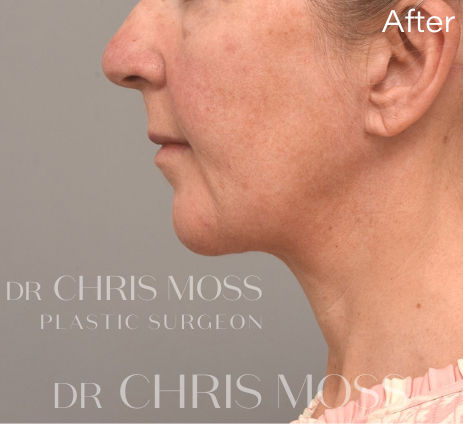
AFTER:
- Extended Lateral (side of) Neck Lift
- Submental (front of) Neck Lift for neck contouring
- Liposuction of jowls
- Micro Fat Injections to grooves below corner of mouth.
The surgical result shown in the ‘After’ image addressed the listed Areas of Concern for Treatment.
Disclaimer: Results vary from person to person. These images are indicative only and reflect the results for this patient. All surgery involves risks & a recovery period – see below.
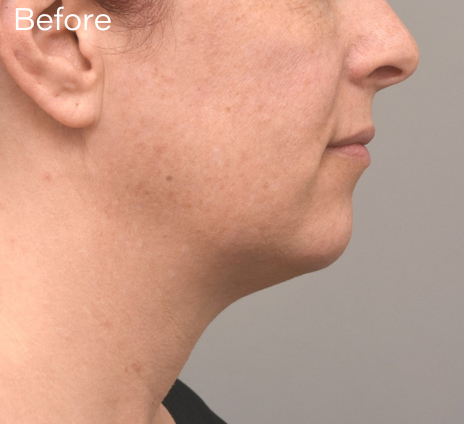
BEFORE:
Areas of Concern for Treatment
- Disliked genetic contour under the chin
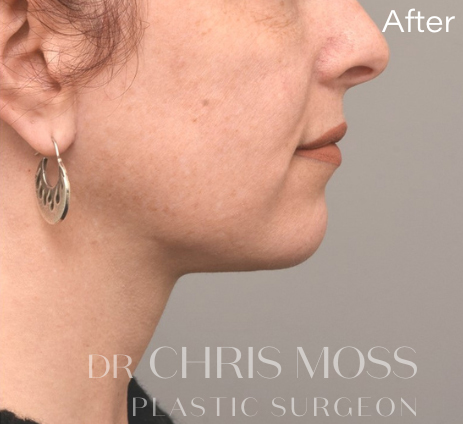
AFTER:
- Submental (front of) Neck Lift
- Submandibular Gland Reduction
- Lateral (side of) Neck Lift
The surgical result shown in the ‘After’ image addressed the listed Areas of Concern for Treatment.
Neck Lift Surgery
Dr Moss offers several options to address different appearance concerns in the neck area. What option is most appropriate will depend on each patient’s aim and concerns – in particular, whether they relate to excess or hanging skin, excess prominence of fat, or poor deep layer support. Neck lift surgery options can be performed alone, together with a Facelift or as part of a broader facial rejuvenation where other separate concerns can be addressed.
What is the best age for Neck Lift surgery?
There is no single best age for Neck Lift surgery. While some patients have surgery in their 60’s or older, most are in their 40’s or 50’s, yet some choose surgery on their neck in their 20’s or 30’s. Those in this younger age group do not have significant ageing, however choose surgery to address inherited neck contour concerns under the chin or along the neckline.
Surgical Options
These procedures can be performed alone or in combination with a facelift procedure. Patients are advised that when there are also concerns about excess facial, cheek or jawline issues, optimal results likely also require some form of facelift procedure.
- Lateral (side of) Neck Lift:
- performed via incisions placed in concealed locations behind each ear and into the hairline.
- involves removal of excess neck skin to help smooth the neck and better define the area under the jawline.
- usually performed in combination with a facelift for improved results.
- in appropriate candidates this can be performed as a stand alone procedure however it is emphasised that when performed alone it will not alone address the jowls or substantially firm the jawline.
- Submental (short incision) Neck Lift:
- performed via short incision concealed under the chin.
- improves neck contour and definition.
- removes excessive fatty tissues from deep to the platysma neck muscle.
- provides firming of vertical neck folds under the chin by tightening of loose platysma neck muscles placement with lasting deep layer support sutures.
- performed in combination with Face and Lateral Neck Lift Surgery for optimal results.
- in those with good skin tone this can be performed as a stand-alone procedure to improve neck contour concerns.
- Lateral (side of) Neck and Submental (front of) Neck Lift:
- combines a Submental Neck Lift with a Lateral Neck Lift.
- helps smooth out loose skin or vertical folds at the front of the neck when there is significant removal of excess neck skin is requested.
- improves contour of the neck line.
- provides an option for combined neck contouring and firming without any facelift in those with significant loose skin where a Submental Neck Lift should not be performed alone.
- Liposculpture:
- suction removal of fat pockets to address concerns about excessive fat deposits beneath the chin or in the jowls.
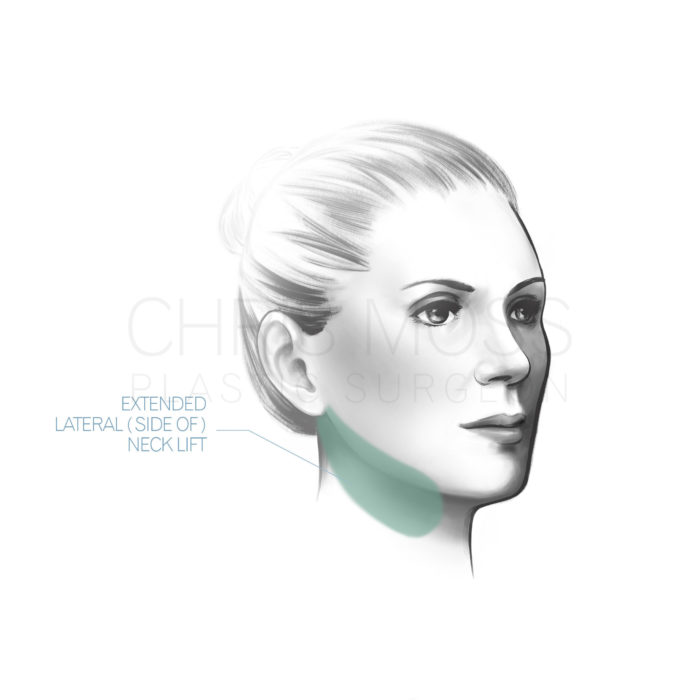
Lateral (side of) Neck Lift
Removal of excess neck skin to help address neck laxity and improve definition under the jawline.
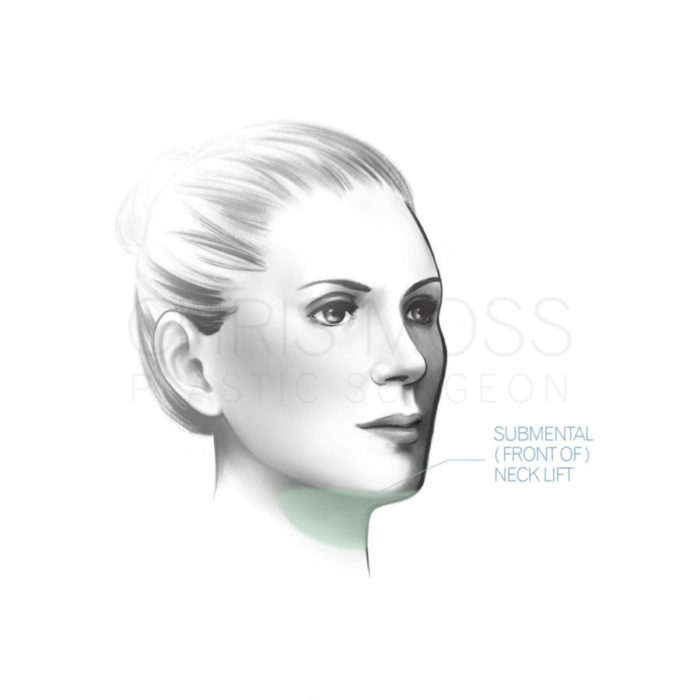
Submental (front of) Neck Lift
Uses lasting deep layer platysma neck muscle support to firm the overlying neck skin, redefine the jaw line and smooth vertical skin folds at the front of the neck.
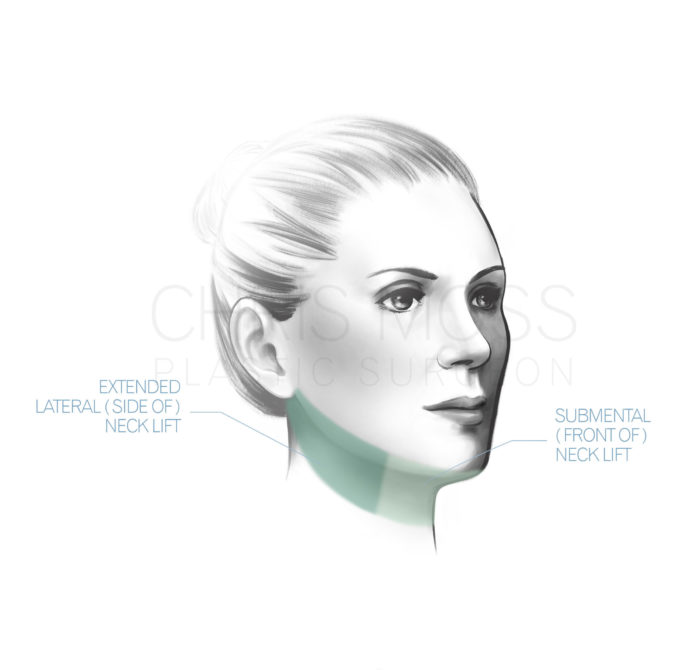
Submental (front of) and Lateral (side of) Neck Lift
Combines a Submental (front of) Neck Lift with a Lateral (side of) Neck Lift.
Neck Lift Results
Disclaimer: Results vary from person to person. These images are indicative only and reflect the results for each patient. All surgery involves risks & recovery period – see below.
Further details and Recovery
Patients undergoing Neck Lift surgery usually stay a night or two in hospital, depending on the extent of surgery. Surgery is performed under General Anaesthetic. Sutures will be removed after 10-14 days and you may be recommended to wear a facial chin strap garment. You can usually return to work and social life 2 weeks after surgery. You can return to light exercise by 2 weeks but refrain from more strenuous activity for 6 weeks.
Risks
All surgery has risks – no matter who performs the surgery. When surgery is performed by a trained and experienced plastic surgeon there will be measures and precautions put in place to help lower the risk of complications occurring. If complications do occur and require further treatment or revisional surgery, then a qualified surgeon is trained to manage such complications. During the consultation, Dr Moss will carefully explain the possible risks of your surgery so that you can make an informed decision.
Different patients will heal differently, and have different pain thresholds and will therefore experience different recovery times for different activities The following possible complications – which apply to all surgeons worldwide – are listed to inform you, rather than to alarm you. A number of these risks are rare and have not occurred to date in Dr Moss’ practice. Further details on the level of any risk in your particular circumstances, including the possible impact of any comorbidities you may have, are provided in your consultation.
All patients are likely to experience some temporary discomfort/pain, numbness or altered sensation around the incisions or operated areas; bruising and swelling; skin discolouration; lumpiness, tightness, fatigue, low spirits; and nausea – typically from the anaesthetics or pain killers, which may require treatment.
General risks of surgery include wound infection; haematoma, abnormal scarring, bleeding from the incisions, allergies or reactions to anaesthetic agents, medications, sutures or topical treatments, delayed healing or separation of wound edges.
Specific Risks of Neck Lift Surgery include rare loss of skin due to impaired blood supply; deformity of an earlobe; damage to deeper structures, nerves or rarely paralysis; new or remaining asymmetry; skin discolouration or capillaries; irregular skin contour; psychological dysfunction or mental illness.
Risks of Anaesthesia include tooth damage; heart attack; pneumonia; blood clot in the leg or lung, and stroke. These are uncommon but could be life threatening.
